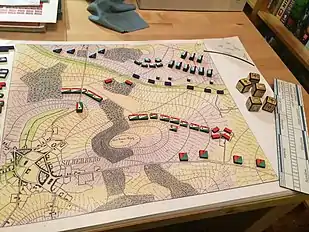Gilbert Roberts (Royal Navy officer)
Gilbert Howland Roberts (11 Oct 1900 — 22 Jan 1986) was an officer in the British Royal Navy. From 1942 to 1943, Captain Roberts operated a naval wargaming unit based in Liverpool called the Western Approaches Tactical Unit (WATU). This unit developed anti-submarine tactics to defend trans-Atlantic merchant convoys from German submarines.
Gilbert Roberts | |
|---|---|
 | |
| Born | October 11, 1900 Kensington, England[1] |
| Died | January 22, 1986 (aged 85) Torbay, England[1] |
| Allegiance | |
| Service/ | |
| Years of service | 1913–1964 |
| Rank | Captain |
| Unit | Western Approaches Tactical Unit |
| Awards | CBE (1944)[2] RD (1964)[1] |
| Spouse(s) | Alice Marjorie Brooks
(m. 1930, divorced)Jean Winifred Warren
(m. 1947) |
| Children | 2 |
Early life
Gilbert Roberts was the second son of Sir Howland Roberts, 12th Baron Glassenbury of Kent and 5th Baronet of Britfieldstown in Cork.[3]
Military career
Roberts joined the Royal Navy as a cadet in September 1913, a month shy of his thirteenth birthday. His first posting was the HMS Hibernia.
From 1935 to 1937, Roberts studied at the Portsmouth Tactical School. There, he discovered naval wargaming, and became an enthusiastic practitioner. Like many wargaming enthusiasts of his time, he developed his own rules, based mainly on the wargames of Fred T. Jane.
Roberts was given command of the destroyer HMS Fearless in autumn 1937. In December, the Fearless joined a flotilla to patrol the Spanish coast (during Spain's civil war). In late 1938 he developed tuberculosis.[lower-alpha 1] He was deemed medically unfit and retired on 28 October 1938.[2][4]
Roberts convalesced at the King Edward VII Sanatorium in Midhurst until April 1939.[2]
On 1 January 1942, Roberts met with Admiral Cecil Usborne in London. Usborne ordered Roberts to report to the Western Approaches headquarters in Liverpool, where he was to establish a unit to develop tactics by which shipping convoys in the Atlantic could defend themselves from German submarine attacks. Through the use of wargames, he studied the reports of convoy escorts, devised defensive tactics, and trained escort commanders in their use.
In 1944, Roberts was tasked with planning the anti-submarine operations that supported Operation Overlord. These proved highly effective.
According to his colleagues and staffers, Roberts was a difficult man to work for. He was noted for being pushy, stubborn, and intolerant of disagreement. Nevertheless, he was liked and respected by his staff. His abrasive personality was likely aggravated by his illness.[5]
The Germans hung a photograph of him in the Operations Room of their U-boat Headquarters in Flensburg, with the caption: "This is your enemy, Captain Roberts, Director of Anti U-boat Tactics".
Promotions
| Promotions[2] | |
|---|---|
| Rank | Date |
| Cadet (entry) | 15 September 1913 |
| Midshipman | 1 January 1917 |
| Acting sub-lieutenant | 15 November 1918 |
| Sub-lieutenant | 15 July 1919 |
| Acting lieutenant | 15 July 1921 |
| Lieutenant | 15 October 1920 |
| Lieutenant-commander | 15 October 1928 |
| Commander | 30 June 1935 |
| Acting captain | December 1942 |
Awards
Footnotes
- Diagnosed by the Surgeon General on the HMS Resolution, likely on Oct 27.
- https://www.unithistories.com/officers/RN_officersR2.html
- Service record of Gilbert Howland Roberts, (UK National Archives, ADM 196/124/8) (archived at Dropbox)
- Williams (1979), Captain Gilbert Roberts, chpt. 1, p. 7
- Williams (1979). Captain Gilbert Roberts, pp. 72-75
- Parkin (2019). A Game of Birds and Wolves, chpt. 17
Bibliography
- Mark Williams (1979). Captain Gilbert Roberts R. N. and the Anti-U-Boat School. Cassell. ISBN 0-304-30386-0.
- Simon Parkin (2019). A Game of Birds and Wolves: The Secret Game that Won the War. Hodder & Staughton. ISBN 9781529353051.
